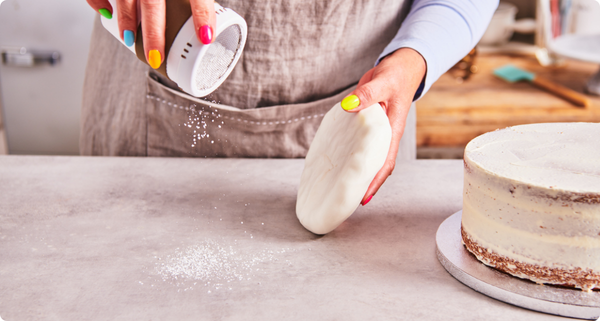Does your sugar paste tear easily while covering a cake? Or want to prevent cracks and rips in your fondant? You’re not alone! Sugar paste tearing is a common issue, but the good news is: it’s usually easy to avoid. In this blog, we’ll explain why sugar paste cracks or tears, and share 5 practical solutions to keep your cake decorating stress-free
Why is my Sugar Paste tearing when covering a cake?
Reason 1: Your sugar paste is to dry
One of the most common reasons sugar paste tears is because it’s too dry. This often happens when you use too much rolling powder or icing sugar, these absorb moisture, causing the paste to dry out. Over-kneading can also reduce elasticity and make it crumbly. Sometimes sugar paste is already dry when purchased, especially if it’s close to the expiry date or not stored properly.
How to fix dry sugar paste
Knead a small amount of Crisco to soften the paste. This vegetable shortening restores flexibility and prevents further tearing. You can also use it to grease cutters or stop paste from sticking.
No Crisco at home? Try kneading the sugar paste with slightly damp hands to rehydrate it.


Reason 2: Your sugar paste is rolled out too thinly
Thin sugar paste may look elegant, but if it’s too thin it becomes fragile. It may tear while lifting or smoothing onto the cake.
What is the perfect thickness for sugar paste?
Roll your sugar paste out to a thickness of 3 to 4 mm. This gives you enough strength to handle the paste while keeping it soft and flexible for shaping.
Reason 3: Your sugar paste is too soft or sticky
Overworked sugar paste or paste that’s been stores in a warm place can become too soft and stretchy. It may sag, shine too much or stick, and that often leads to tearing.
How to fix soft sugar paste
Let the sugar paste rest at room temperature, covered, so it doesn’t dry out. You can also knead in a bit of Tylo powder, it will strengthen the paste and improve the workability.


Reason 4: You’re pulling the sugar paste too tightly over the cake
Stretching you paste too tightly when covering a cake, especially downward, causes tensions, which leads to small tears, often right below the top edge. This happens a lot with tall cakes or cakes with sharp corners
Best technique to avoid tearing
Gently guide the paste over your cake. Don’t stretch it down, instead, let it naturally follow the shape. Use your hands or a decorating smoother to work from the top down. Lift any folds and smooth them out carefully.
Reason 5: Your work surface is too dry or sticky
A poor work surface can also cause tears! If your surface is too dry of sticky, the sugar paste can cling and rip while you roll or lift it.
How to prepare your surface before decorating with fondant
Lightly dust your worktop with rolling powder or icing sugar, but not too much. Alternatively, rub a thin layer of Crisco onto the surface. A non-stick mat or silicone baking mat is also a great option.
How to repair cracked or torn sugar paste?
Noticed cracks after you’ve already covered the cake? Don’t worry, you can still save it! Take a small piece of moist sugar paste, gently place it into the crack, and smooth it over.







